This article has been updated to add corrected text.
A request from the Republic of Turkey to block United States importation of Turkish art and ethnographic materials from the Prehistoric Period to 1923 is pending before the Cultural Property Advisory Committee in the State Department’s Bureau of Educational and Cultural Affairs. Testimony will be taken in writing by January 7, 2020 (enter docket DOS-2019-0043), and from the public at a hearing on January 21.
The U.S. law that would enable such a blockade, the Cultural Property Implementation Act (CPIA), was originally used to create limited import restrictions on archaeological materials subject to extensive, current looting. No more. Archaeological protection claims are only a thin justification for blanket import controls today. What Congress feared, that the CPIA would become a diplomatic tool in the hands of the State Department, has come true. This U.S. legislation is now used to block importation of virtually all art from 23 countries – in many cases, serving a particular foreign regime’s political purposes by effectively nationalizing ancient, ethnic, community, and religious human heritage.
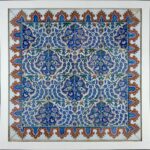
Tile Panel, 2nd half 16th century, Iznik, Turkey, stonepaste, Metropolitan Museum of Art, NY, Gift of J. Pierpont Morgan, 1917.
The agreement requested by Turkey would recognize its government’s ownership of art made over the entire history of the region. In Turkey’s case, the historic movement of populations over time raises issues of whose culture is actually being claimed. Turkey’s early modern history of ethnic discrimination and genocidal abuse, the fact that there have been large exchanges of population with neighboring Greece in the 20th century, the increasing antisemitism unchecked by President Recep Tayyip Erdoğan’s government today, and other factors resulting in significant movement of non-Muslim communities into the diaspora – some of whom lived in the region for thousands of years – complicates any decision to impose import restrictions under the CPIA.
In addition, the import restrictions sought by Turkey from the U.S. appear to have little to do with archaeological sites being currently at risk or significant theft of objects – except in some cases by site guards and locals. By law, certain conditions must exist in the source country to place categories of objects on the Designated List of restricted objects. Instead the Turkish government has submitted a laundry list of every conceivable item made by human hands – objects from 1.2 million to 97 years old.
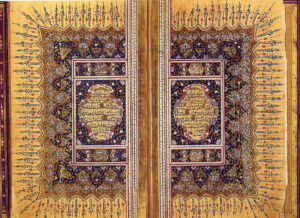
Qur’an Manuscript, dated A.H. 1268/A.D. 1851–52, Turkey, Ink, opaque watercolor, and gold on paper; leather binding, Metropolitan Museum of Art, NY, Gift of Elizabeth M. Riley, 1980
In the past, Turkey has also demanded rights in objects representing “Ottoman” culture from neighboring countries over which Turkish rulers held sway in centuries past. It is not clear the degree to which Turkey could claim such objects under a U.S. agreement.
Despite having a strong cohort of well-trained Turkish archaeologists and a public that is generally committed to protecting archaeological remains, the Turkish government has been willing to sacrifice archaeological preservation in the cause of infrastructure development, most recently for example, in this year’s filling of the Hasankeyf valley, covering an estimated 300 historical and archaeological sites with water to create the Ilisu Dam and hydroelectric project.
As recent incidents of deliberate archaeological destruction both inside Turkish borders and in neighboring Syria by the Turkish government make clear, demands for archaeological protection can serve as camouflage for the political, religious, and economic goals of its ruling party. Claims of state ownership of objects of religious heritage belonging to religious minorities, seizures of religious properties and the conversion of former churches to mosques are symptoms of President Recep Tayyip Erdoğan’s government’s increasing pressure on Jewish, Christian, and other minority communities. In recent years, the current Turkish government has disregarded its strongly secular constitution to encourage popular Turkish Muslim nationalism that serves the current regime’s political aspirations.
Many, even most Turkish citizens take great pride in their rich and diverse cultural background. They see the magnificent achievements of its past inhabitants as theirs as well. They acknowledge the great contributions of a multitude of peoples and cultural influences to Turkish culture and want to preserve and honor that history. This is all to the good. But that does not mean that the cultural riches of the past should be allowed to be made into a propaganda tool for the aggrandizement of any regime.
Centuries of Integration, Followed by a History of Massacres of Non-Muslim Populations
A serious issue with recognizing Turkish national ownership of all of the relics of Turkey’s past is that until the 11th century CE, ethnic Turks had little to do with its culture. Prior to the appearance of Turkic peoples pushing west and south from the steppe regions of Central Asia, much of Turkey had been inhabited by Greeks, whose colonies, well-established in the first millennium BC, had had a strong Hellenizing influence on indigenous populations. As rulers of the eastern Roman empire, Byzantium was the preeminent center of Greek as well as Christian culture. After the establishment of the Seljuk and Ottoman empires, multi-ethnic communities existed in relative peace until the 19th century, when Greece’s war of independence triggered reprisals against local Greek populations. After the Greek War of 1919-1922, massacres of Greeks, Armenians and Turks were followed by forced movements in which many thousands of Greek residents died.
Armenian peoples have lived near Mt. Ararat in eastern Turkey for more than 2000 years, leaving behind archaeological remains demonstrating high civil and artistic achievement across present day Turkey. Armenians were integrated into the administrative rule of the Byzantine and Ottoman empires. Inter-religious tension rose in the 19th century in part as a result of Muslim perceptions of Armenians as aligning politically to their fellow-Christians among the European powers jockeying to portion out the shrinking Ottoman empire. Horrendous mass murders, including the burning of 3000 Armenians who had taken refuge in the Cathedral at Edesssa, marked decades of appropriations of property and possessions. The Armenian people suffered almost complete destruction in the forced deportations, planned starvation, and routine massacres of the populations of Armenian towns starting in 1915. Armenians in Turkey ceased to exist. Those who survived made their way into Europe, Africa, and especially the United States.
Many descendants of these and other communities that were forced from Turkish territory in the past have now made their homes in the United States, which now has one of the largest Armenian populations in the world. An import blockade would grant the Turkish government rights not only over ancient Greek sites and artifacts, but also over the heritage of Armenian, Christian, and Jewish communities, hundreds of thousands of whom were driven into exile by the Turkish government in the nineteenth and early twentieth centuries.
Legal Status of Faith Communities in Turkey Today
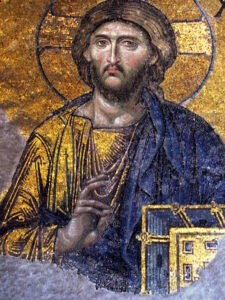
Mosaic (Jesus) from Hagia Sophia, Author Acaro, August 2005, Creative Commons Attribution 2.5 Generic license.
Minority religious communities in Turkey do not operate under a stable regulatory framework. Only a limited number of legal entities are able to rent or acquire property. Foundations known as vakıfs do not have the legal independence to securely retain properties. In contrast, Muslim communities are able to obtain legal identities and exercise property rights under the aegis of a government agency, the Directorate of Religious Affairs.
The Lausanne Peace Treaty of 1923 established protection for Turkey’s non-Muslim religious communities, but the treaty specifically identified only three protected religious groups, the Armenian, Greek Orthodox, and Jewish communities. These three have a relatively protected status under the law, although each local community must independently manage its own churches, cemeteries, and community schools under local laws. Other non-Muslim minority groups do not have even this legal recognition. Their situation is so challenging with respect to property that the European Commission for Democracy Through Law recommended in 2010 that Turkey implement legislation to give minority religious communities legal standing.
In the last decade there have been efforts by the Turkish government to enable non-Muslim community foundations to regain some properties taken from them in the past. The Restitution Decree of 2011 provided a legal framework under which religious communities whose property had been confiscated by the government could seek to regain it or to obtain compensation for their losses. In January 2019, the first permit ever granted for a church to be constructed in the modern Turkish era was issued for the construction of a Syriac Christian Church in Istanbul.
There have also been some important returns of property. Fifty properties were returned to the Syriac Orthodox Church in Mardin in 2018. These included the oldest surviving Syriac Orthodox monastery, Mor Gabriel Monastery. A decision to transfer eleven buildings on Bozcaada Island to the Greek Orthodox Foundation was officially announced in 2014, but six years later, those properties have not yet been transferred.
Other very long-standing disputes regarding properties have not been favorably resolved for the religious communities. The forced removal of Christians from Turkish towns naturally resulted in the closing of schools and other religious institutions, which were then seized by the state because they were deemed nonfunctional. A government decision that a vakıfs is no longer operating has been a common method of expropriation of religious minority communal property.
For example, the Sanasaryan Han in Istanbul was seized by the government in 1936. Due to the forced removal of the Armenian population, the college situated there could no longer operate. In March 2019, the Turkish Court of Cassation announced that it was reversing a lower court decision granting the property to the Armenian Patriarchate. It held that title to the property would remain with the state. A key barrier is that the Patriarchate has still not been able to acquire the status of a vakıfs foundation.
While past Turkish administrations have achieved relatively positive working relationships with the Jewish communities specifically protected under the Lausanne Treaty, the Erdoğan government no longer pursues cooperative relations with Israel, and the Jewish population of Turkey suffers as a result.
Today, the fragile remnants of these communities in Turkey remain under extreme political pressure. The Erdoğan government appears unwilling to act to halt anti-Semitic demonstrations and the rise of hate speech against non-Muslim faiths. Despite the protections previously assured under the Turkish Constitution, the failure of the Turkish government to grant full legal status to any faith community after almost 100 years has had a very debilitating effect on the non-Muslim minority religious communities that remain. If Jews, Orthodox Christians, and other religious minorities do wish to leave the country, they must be willing to leave behind the most precious relics of their religious communities.
Government Claims over Major Christian Monuments
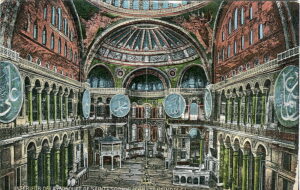
Postcard, undated ( ca.1914 ). Title: “Interior of the mosque of Saint Sophia ( Constantinople ) 13 October 2008, private collection of Wolfgang Sauber (Xenophon), public domain.
When the Republic of Turkey was founded in 1923, its first president was Mustafa Kemal Atatürk, who instituted widespread reforms to create a secular country. At Ataturk’s orders, a number of mosques that were formerly Christian cathedrals were converted into museums; the most famous example, the Hagia Sophia in Istanbul, was made into a museum in 1935.
Several times in recent years, Erdogan has urged the conversion of Hagia Sofia and other major monuments of the eastern Orthodox faith from museums into mosques. During a 2013 election, Erdoğan, then Turkey’s Prime Minister, attempted to make Hagia Sofia’s conversion both a religious and nationalist issue in his campaign. A similar campaign in 2014 in Istanbul saw protests organized by Erdoğan’s Justice and Development Party (AKP) party demanding Hagia Sophia’s conversion. Just days before Istanbul’s elections were scheduled on March 31, 2019, President Erdoğan declared that the 1500-year-old Hagia Sophia, now a museum, should be made into a mosque. The call for Hagia Sofiia’s conversion has been repeated several times in 2019.
Hagia Sophia is one of the best-known UNESCO World Monuments, and the second most popular museum in Turkey, drawing over three million visitors each year. In February 2019, Greek Prime Minister Alexis Tsipras visited Hagia Sophia, calling it “an iconic and disputed landmark in Istanbul which has recently been at the centre of tensions between Athens and Ankara over Muslim activity.”
Erdoğan’s call to turn Hagia Sophia into a place of worship contradicts multiple domestic laws and international undertakings by the government of Turkey. The 1906 Fourth Antiquities Code and 1926 Turkish Civil Code Law No. 1710 protected monuments as state properties, and established parameters for protection of historic buildings such as Hagia Sophia for most of the 20th century. However, by 1983, the management system for cultural properties under these laws was too antiquated to deal with the increasing number of historical sites.
Law No. 2863 of 1983 regarding the Protection of the Cultural and Natural Assets established both a Superior Council and Regional Councils for the Protection of Cultural and Natural Assets. This law places decision-making regarding the physical interference with, and the use or change of purpose of cultural assets, within the scope of the Ministry of Culture and Tourism.
Among other international agreements on cultural heritage, Turkey ratified the 1972 Convention Concerning the Protection of the World Cultural and Natural Heritage on March 16, 1983. This international convention specifically provides for its member countries to nominate World Heritage properties, which include Hagia Sophia.
Most Recent Government Project Threatens Vast Archaeologically Rich Hasankeyf Region
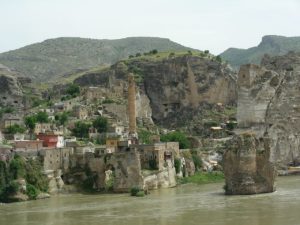
Hasankeyf, 23 May 2007, Photo by Herbert Frank from Wien, Creative Commons Attribution 2.0 Generic license.
The massive Ilisu Dam, already being filled, will cover 115 square miles of an ancient Tigris River valley with water for the Hydra hydroelectric project in Turkey’s Kurdistan region. Salvage archaeology begun in 2006 accounts for only 15% of the sites; the rest will disappear forever.
The Turkish government says it is needed to generate power to serve the agricultural lands surrounding it, but the fields of the farmers currently living there will be submerged. However, communities dating back thousands of years will be destroyed, including the 12,000-year-old town of Hasankeyf, believed to be one of the world’s oldest cities. Hasankeyf contains remains of Neolithic cave-dwellers, a Byzantine bishopric, a Seljuk city, Arab fortress, and Ottoman military outpost. More than 300 historical sites will be submerged. The dam that will inundate these thousands of years of history is estimated to last for only 100 years. Archaeologists say that the inundation of the ancient fields and gardens will remove key evidence of ancient rural sites since few such remain untouched.
Turkey Claims Objects in Foreign Museums, Threatens End to Archaeological Studies if Not ‘Returned’
The government of Turkey has warned U.S. and foreign museums that unless ancient objects from Turkish soil are returned, Turkey will stop lending artworks. Despite Murat Suslu, Turkey’s director general for heritage and museums, statements that Turkey was seeking cooperation in cultural patrimony matters, in 2012-2013 the Metropolitan Museum in New York, the J.Paul Getty Museum in Los Angeles, and the Pergamon Museum in Berlin all received demands for the return of objects that have been in the museums’ collections for decades in what many called an “art war.”
While museums in the US are willing to discuss the return of objects with questionable provenance, particularly those acquired after the 1070 UNESCO Convention, Turkey has demanded the return of numerous objects that left Turkey in the 19th and early 20th century, including artworks whose export was negotiated with the Ottoman government.
Turkey says it wants proof that foreign museums have legal rights to numerous objects based upon Ottoman laws of 1884 and 1906. It says it has both legal and moral claims to artworks that have rested in foreign museums for more than a century.

Vessel terminating in the forepart of a stag, ca. 14th–13th century B.C. Hittite Empire, Central Anatolia, Gift of Norbert Schimmel Trust, 1989, Metropolitan Museum of Art, NY.
Unless high-value artworks were returned, Turkey promised to punish museums by ending international art loans and delaying or cancelling excavation permits for foreign archeologists. For example, Turkey revoked French archaeologists’ excavation permits at the Xanthos World Heritage site because the Louvre would not return objects donated to that museum in 1895.
In 2011, Turkey insisted that the Pergamon Museum in Germany return a Hittite sphinx that had been in Germany since 1917 or it would terminate a major archaeological project. Germany complied, but Turkey still refused to lend objects for an exhibition until additional items were returned.
The Turkish actions have prompted a critical response from many quarters. Observers saw the Turkish claims as leading the way for other nations to demand return of treasures that have been in Western museums for many decades. Jason Farago, writing in The Guardian in 2012, referred to Turkey’s and other nations’ repatriation demands as “an infinite claim to a cultural heritage that may date back thousands of years before the state’s foundation,” conceiving the nation state as “something organic, an unchanging territorial bond, rather than a relatively recent phenomenon in world history.” Some have also seen Turkey’s claims as a part of a plan to fill the 270,000 square foot “Museum of the Civilizations” to be completed in Ankara in 2023.
Turkey’s Want List
Objects sought by Turkey from international museums have included:
- The Louvre: late 16th century tiles from the mausoleum of Selim II brought to Paris by dentist/restorer Albert Sorlin-Dorigny in the 1880s, given to the Louvre in 1895.
- Metropolitan Museum of Art, New York: 18 objects from the Norbert Schimmel collection, purchased n Europe in the 1960s and donated by Norbert Schimmel in 1989.
- J. Paul Getty Museum, Los Angeles: 10 artifacts including four bronze statutes of Muses, 200 AD, formerly in the collection of art dealer Ellie Burowski in the 1960s.
- Pergamonmuseum, Berlin: The Pergamon Altar, acquired in a agreement with the Turkish government after German archeologist Carl Humann found Turkish workmen smashing ancient statuary for lime kilns at the site in 1864; acquired through an 1879 agreement with the Ottoman government; plus a 2000 year old statue of “Old Fisherman from Aphrodisias” purchased from an art dealer in Izmir in 1904.
- Museum of Islamic Art, Berlin: the ornamental structure of a medieval tomb and a 13th century mihrab from Konya.
- Dumbarton Oaks (Harvard University), Washington D.C.: Sion treasure of 6th century Byzantine liturgical silverware.
- Cleveland Museum of Art: 22 objects including the Cycladic marble figure “The Stargazer”, statue of Jesus Christ as “The Good Shepherd.”
- British Museum, London: the Samsat Stele, purchased in 1911 by archaeologist Leonard Wooley from a farmer who had been using it as an olive press.
- Victoria and Albert Museum, London: 3rd C. BC fragment of a Sidamara sarcophagus.
- Cleveland Museum of Art: Bronze statue of Marcus Aurelius.
- Bowling Green State University: a Roman mosaic, possibly from Zeugma.
The Request Covers All Objects, But Turkey Has Sought Repatriation of the Most Valuable
At times, despite being aware of a disputed object’s location, Turkey failed to make claims for these until their market value had appreciated considerably– and has not made claims for similar objects that have been on longer term public display. The Public Summary avoids this issue, stating that high valuation and an active market abroad result in theft; but there is no mention of any specific objects illicitly removed in recent years offered for sale in the U.S.
According to the Public Summary, “It is known that many cultural objects originating in Turkey exist in several museums and private collections in the USA and Europe. The sales at auction houses abroad as well as the online sales show that there is a flow of cultural property from Turkey to other countries.” What these sales show is that in the past, objects exited Turkey in many legal (at the time) or authorized ways, including through partage in archaeological excavations over more than 150 years, not that there is current illegal traffic between Turkey and the U.S.
Turkey Seeks to Include Commercial Products Widely Exported for Hundreds of Years
Many of the so-called “ethnographic “objects called out in the public summary that date to 1923 and earlier have been commercially produced and exported from Turkey to countries all over the world. These include furniture, ceramic tiles, vessels and plates, various forms of metalwork, and literally millions of carpets, embroideries and other textiles. Similar items, both antique and modern, continue to be lawfully exported from Turkey today. Several of the largest antique textile dealers in the world have shops in Istanbul that regularly supply both visiting tourists and overseas galleries and auction houses with objects that would appear to be covered under the Turkish request for U.S. import restrictions.
It should be noted that for decades Turkish law has required that items be reviewed not only by customs officials but also by volunteer experts, often associated with academic institutions and museums, before airfreight and container shipments are exported. This export process is internal: after the shipments are cleared through Turkish customs, they are not given special documents to accompany the objects. If Turkey provides no documents to legitimate exporters, it raises questions about how the thousands of items exported each year can be proved to have been lawfully exported.
Reports By the World Customs Organization Raise Serious Questions About Volume of Seizures and What Turkey Considers Cultural Objects
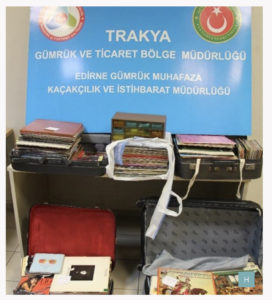
The largest single seizure of cultural goods in Turkey in 2017. This illustration appears on page 18 of the World Customs Organization 2017 Illicit Trade Report, “Successful cooperation between Customs and culture experts in Turkey,” p. 18, World Customs Organization 2017 Illicit Trade Report.
Not all ‘cultural objects’ are created equal, but under Turkish law it seems that they don’t have to come from Turkey, or even be old. Two cases comprise the largest seizures of cultural objects executed by Turkish Customs units in 2017, according to the World Customs Organization 2017 Illicit Trade Report, p 18.
“In April 2017, at the Edirne, Kapıkule border crossing point, a truck coming from France via Bulgaria, was subject to a routine control by Customs officers. During the cabin search of the truck, officers seized 250 pieces of 45-rpm and 260 pieces of 33-rpm phonograph records. Then, in September 2017, a car coming from the Netherlands via Bulgaria, through the same border crossing point, was considered “high risk” and thereby deserving of a physical search that led to the seizure of 2,400 long-play records. According to the expert’s report for this case, these records were considered protected within the scope of national legislation.”
The photograph is fuzzy, but sitting atop these seized records is Leonard Cohen’s 1969 album Songs from A Room. According to the World Customs Organization, the LPs and 45s were considered protected cultural heritage within the scope of Turkish national legislation.
Turkey Deliberately Destroyed a Major Archaeological Site Just Across the Syrian Border
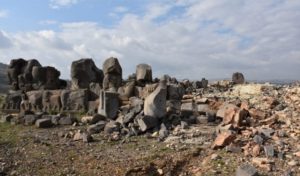 Establishing its ability to act with impunity across the border in Syria, in January 2018, the Turkish government destroyed the most outstanding Syro-Hittite monument ever excavated, the Iron Age temple of ‘Ain Dara, near to the northern Syrian town of Afrin. Although the site was open to the sky, providing no possible cover (and no claim was made by Turkey that insurgents were present), the bombing was said to be part of an aggressive campaign against Kurdish separatists called “Operation Olive Branch.” The campaign was apparently intended to extend Turkey’s buffer zone along the Syrian border. The nearby town of Afrin was also severely damaged. The Syrian Observatory for Human Rights (SOHR) said that Turkish bombings of nearby towns during the campaign killed at least 55 civilians; Turkey did not acknowledge the civilian deaths.
Establishing its ability to act with impunity across the border in Syria, in January 2018, the Turkish government destroyed the most outstanding Syro-Hittite monument ever excavated, the Iron Age temple of ‘Ain Dara, near to the northern Syrian town of Afrin. Although the site was open to the sky, providing no possible cover (and no claim was made by Turkey that insurgents were present), the bombing was said to be part of an aggressive campaign against Kurdish separatists called “Operation Olive Branch.” The campaign was apparently intended to extend Turkey’s buffer zone along the Syrian border. The nearby town of Afrin was also severely damaged. The Syrian Observatory for Human Rights (SOHR) said that Turkish bombings of nearby towns during the campaign killed at least 55 civilians; Turkey did not acknowledge the civilian deaths.
CPN reported at the time:
“Ain Dara was built after the collapse of the Hittite Empire around 1180 BC, by peoples known as Syro-Hittites or Neo-Hittites. According to reports, the 3,000-year-old site has been 60% destroyed and its gigantic stone statues turned to rubble. The Syrian Antiquities and Museums Directorate denounced the bombing as a barbaric attack against Syrian identity. It should be noted however, that the Syrian government has not acknowledged the destruction of monuments by Syrian government and Russian forces in similar terms.
Prior to the Turkish bombing, Ain Dara was famous not only for its massive stone statues of lions and sphinxes, but also for its intricately patterned wall-carvings – and for a mysterious set of giant, three-foot-long footprints carved into its stone entryways. Based upon a diagram of the site on the American Schools for Oriental Research website, the main walls and remaining structures of the site, including these giant footprints, and the massive statues lining its carved walls, suffered the worst damage. Archaeologist Salah el-Din Senno, a member of the local antiquities council, told Delil Souleiman of Agence France Press that, “The damage began from the entrance and extended to the interior – the legendary animal statues, guardians of the temple, and other sculptures representing the gods were scattered…Stone slabs were thrown a distance of 100 metres.”
This is Not the Proper Time to Grant Import Restrictions
The Turkish government request comes at a time when its government is making extraordinary claims of ownership and control over the cultural heritage of civilian minorities subject to discriminatory treatment contrary to the Turkish constitution. Destruction of local communities to make way for development is undertaken with impunity, for example in the construction of the Ilisu Dam. Religious minorities face an increasingly uncertain position in society while the Turkish government makes little effort to ensure that constitutional protections are enforced.
It is inappropriate – even unconscionable – for the US Government to sign an agreement that recognizes the present Turkish regime as a good steward of the cultural property of peoples who have been driven out, and whose history of discrimination the current government refuses to recognize. The Turkish government’s unsubstantiated claims of sporadic looting by Turkish citizens for the market can in no way serve as a basis for all-encompassing import restrictions on Turkish art. Nor does that same government’s flooding of ancient cities, destruction and conversion of churches into mosques, and sponsoring of looters in Syria meet the standards set by Congress for self-help actions to preserve cultural heritage under the Cultural Property Implementation Act.
Comments on the Requests
Public comments on the requests from Turkey and Tunisia must be submitted in writing no later than January 7, 2020, at 11:59 p.m. (EDT). Use regulations.gov, enter docket DOS-2019-0043, and follow the prompts to submit written comments.
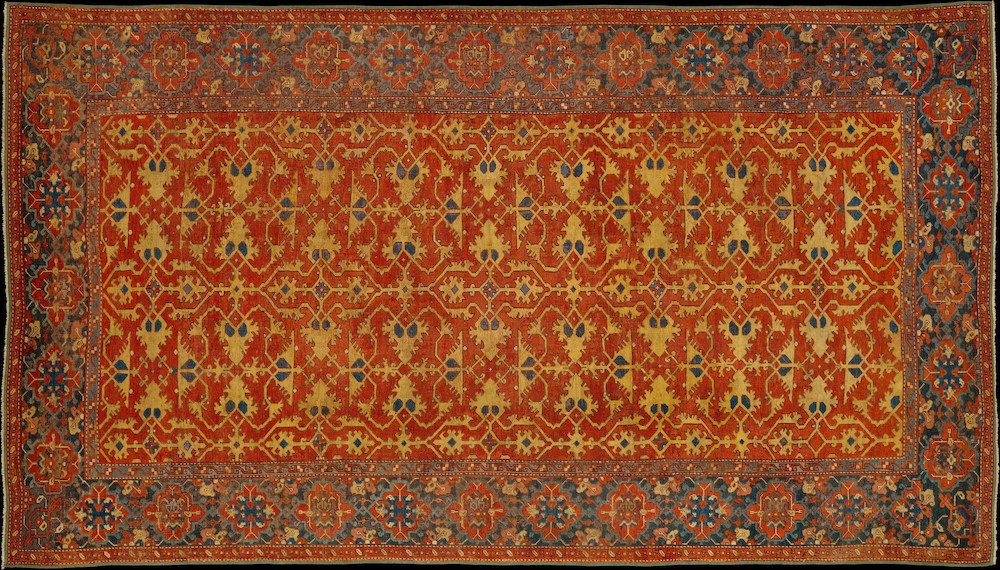 'Lotto' Carpet, late 16th century, Attributed to Turkey, The Seley Foundation Inc. and The Louis E. and Theresa S. Seley Foundation Inc. Gifts, 1978, Metropolitan Museum of Art, NY.
'Lotto' Carpet, late 16th century, Attributed to Turkey, The Seley Foundation Inc. and The Louis E. and Theresa S. Seley Foundation Inc. Gifts, 1978, Metropolitan Museum of Art, NY. 

